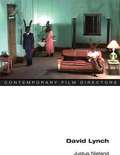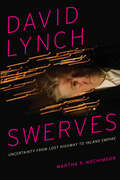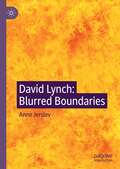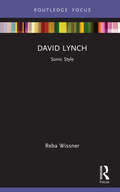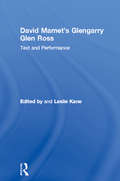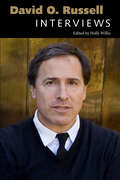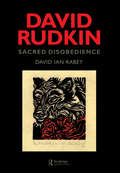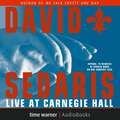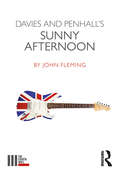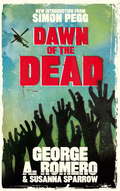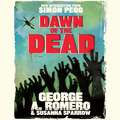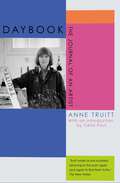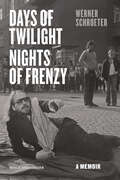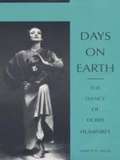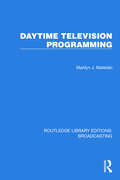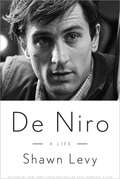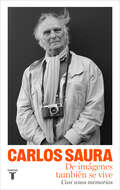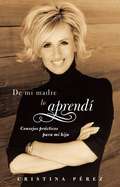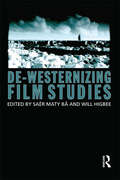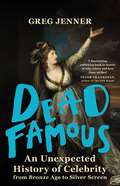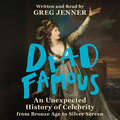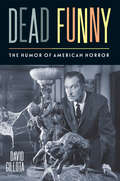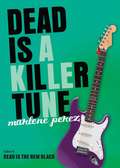- Table View
- List View
David Lynch (Contemporary Film Directors)
by Justus NielandA key figure in the ongoing legacy of modern cinema, David Lynch designs environments for spectators, transporting them to inner worlds built by mood, texture, and uneasy artifice. We enter these famously cinematic interiors to be wrapped in plastic, the fundamental substance of Lynch's work. This volume revels in the weird dynamism of Lynch's plastic worlds. Exploring the range of modern design idioms that inform Lynch's films and signature mise-en-scène, Justus Nieland argues that plastic is at once a key architectural and interior design dynamic in Lynch's films, an uncertain way of feeling essential to Lynch's art, and the prime matter of Lynch's strange picture of the human organism. Nieland's study offers striking new readings of Lynch's major works (Eraserhead, Blue Velvet, Wild at Heart, Mulholland Dr., Inland Empire) and his early experimental films, placing Lynch's experimentalism within the aesthetic traditions of modernism and the avant-garde; the genres of melodrama, film noir, and art cinema; architecture and design history; and contemporary debates about cinematic ontology in the wake of the digital. This inventive study argues that Lynch's plastic concept of life--supplemented by technology, media, and sensuous networks of an electric world--is more alive today than ever.
David Lynch Swerves: Uncertainty from Lost Highway to Inland Empire
by Martha P. NochimsonA study of the role of quantum physics and the Holy Vedas in the later works of filmmaker David Lynch.“The richness of Nochimson’s writing, the thoroughness of her interpretation, and her assured stance in opposition to the canon of Lynch criticism to date all make David Lynch Swerves a must-read for anyone interested in the films of David Lynch. Or, for that matter, the state of film criticism in American culture. If criticism at its best is a form of revelation, then this is practically a new gospel.”―House of SpeakEasyBeginning with Lost Highway, director David Lynch “swerved” in a new direction, one in which very disorienting images of the physical world take center stage in his films. Seeking to understand this unusual emphasis in his work, noted Lynch scholar Martha Nochimson engaged Lynch in a long conversation of unprecedented openness, during which he shared his vision of the physical world as an uncertain place that masks important universal realities. He described how he derives this vision from the Holy Vedas of the Hindu religion, as well as from his layman’s fascination with modern physics.With this deep insight, Nochimson forges a startlingly original template for analyzing Lynch’s later films—the seemingly unlikely combination of the spiritual landscape envisioned in the Holy Vedas and the material landscape evoked by quantum mechanics and relativity. In David Lynch Swerves, Nochimson navigates the complexities of Lost Highway, The Straight Story, Mulholland Drive, and Inland Empire with uncanny skill, shedding light on the beauty of their organic compositions; their thematic critiques of the immense dangers of modern materialism; and their hopeful conceptions of human potential. She concludes with excerpts from the wide-ranging interview in which Lynch discussed his vision with her, as well as an interview with Columbia University physicist David Albert, who was one of Nochimson’s principal tutors in the discipline of quantum physics.“The book succeeds in making more sense of Lynch's more puzzling works . . .Recommended.” —Library Journal“This book is nothing less than a revelation of a new David Lynch . . .so convincing are the book’s claims, so well-substantiated and explained. . . . The focus on the physics of Lynch is a true paradigm shift in our understanding of the director. Nothing will ever be the same in Lynch studies again.” —Eric G. Wilson, Professor of English, Wake Forest University, author of The Strange World of David Lynch: Transcendental Irony from Eraserhead to Mulholland Dr.
David Lynch: Blurred Boundaries
by Anne JerslevThis book distinguishes itself from earlier books on David Lynch by taking in-depth consideration of his entire oeuvre. Besides his films and the Twin Peaks series, David Lynch: Blurred Boundaries includes discussions of Lynch’s paintings and drawings, music videos, commercials, short experimental works, digital projects on the YouTube channel David Lynch Theater and the Internet documentary The Interview Project, as well as the exhibition The Air is on Fire, which Jerslev regards as one of Lynch’s main works. David Lynch: Blurred Boundaries offers a view of Lynch’s total work, in which one medium or genre is no more important than the other. It discusses the ways in which Lynch has worked throughout his career with different art forms and has right from the start experimented with the blurring of boundaries between media and genres. And it discusses ways Lynch creates atmospheres by different audio-visual and visual means.
David Lynch: Sonic Style (Filmmakers and Their Soundtracks)
by Reba WissnerDirector David Lynch is best known for films that channel the uncanny and the weird into a distinct "Lynchian" aesthetic, in which sound and music play a key role: Lynch not only writes his intended sounds into the script but also often takes on the role of creating the sounds himself. This concise study explores what makes Lynch’s sonic imprint distinct, breaking down three different sound styles that create Lynch’s sound aesthetic across his films. Showing how sound offers new insights into the aesthetic and narrative work of Lynch’s filmmaking, this book highlights new dimensions in the work of a key American auteur and deconstructs the process of building a unique sound world.
David Mamet's Glengarry Glen Ross: Text and Performance (Studies In Modern Drama Ser. #Vol. 8)
by Leslie KaneFirst published in 1997. Routledge is an imprint of Taylor & Francis, an informa company.
David O. Russell: Interviews (Conversations with Filmmakers Series)
by Holly WillisDavid O. Russell (b. 1958) boasts a diverse body of work as a writer and director, spanning multiple genres and featuring radically differing aesthetic styles. While his early work comically explored taboo subjects with unerring directness, he has also investigated politics with explosive satire. In his most recent films, including American Hustle and Silver Linings Playbook, Russell examines characters and situations that are at once everyday and also extraordinary. Whatever the project, Russell is driven to explore the idiosyncrasies that make each character human, and he extends that curiosity to explore what makes each actor unique. His attentiveness to his cast members has earned him the label of "actor's director," due in no small part to the many nominations and awards earned by a long list of Hollywood stars in his movies.Russell has also become one of our era's most interesting formal stylists as he adopts a visual design appropriate to each of his film's thematic concerns. The result may be a color palette resembling the washed-out pages of a newspaper achieved by manipulating the film stock for Three Kings or the tumultuous opening of The Fighter when an audacious, roving camera plunges viewers straight into the story from the very first shots of the film. Rather than building a signature style, Russell has instead tested the varied possibilities of cinematic expression.This career-spanning volume features conversations with scholars and journalists as well as filmmakers. Speaking to directors like Alexander Payne and Spike Jonze, Russell contextualizes each of his films, offers an intimate account of his evolving writing and directing process, and opens his life to reveal how a remarkable body of work has come to be.
David Rudkin: An Expository Study of his Drama 1959-1994
by David Ian Rabey David I. RabeyDr. Rabey's profound critical study of David Rudkin's drama constitutes an in-depth evaluation of this unique dramatist, re-assessed in the light of his bi-sexuality and Anglo-Irish origins. This key study includes insights from noted performers of Rudkin's work, including Ian Hogg, Peter McEnery, Ian McDiarmid, Gerard Murphy, and Charlotte Cornwell. It is a fully authorized study with exclusive reference to archival material which includes some frank and urgent interview contributions from the dramatist himself, who is usually deemed reclusive. It is enhanced by Dr. Rabey's own experience of Wales, Ireland, and the English Black Country for his exposition of Rudkin's mythic sense of Celtic and Mercian history.
David Sedaris Live at Carnegie Hall
by David SedarisNo one renders the pathos, chaos and impossible variety of daily encounters like David Sedaris. On every subject, he is bruisingly painful and tenderly affectionate. Recorded live on October 22, 2002, LIVE AT CARNEGIE HALL features excerpts from his forthcoming collection of essays, DRESS YOUR FAMILY IN CORDUROY AND DENIM.Includes:ThanksRepeat After MeWhy Them?Who's the Chef?Buddy Can You Spare a Tie?LessonThree: The Feminine MistakeLesson Four: With a Pal Like This, You Don't Need An EnemySix to Eight Black Men
David Susskind: A Televised Life
by Stephen BattaglioA rich biography of one of the most important cultural figures of the ‘50s, ‘60s and ‘70s—maverick television producer and talk show host David Susskind A flamboyant impresario who began his career as an agent, David Susskind helped define a fledgling television industry. He was a provocateur who fought to bring high-toned literary works to TV. His series East Side/West Side and N.Y.P.D. broke the color barrier in casting and brought gritty, urban realism to prime time. He indulged his passion for issues and ideas with his long running discussion program, first called Open End and then The David Susskind Show, where guests could come from The White House one week and a whore house the next. The groundbreaking program made news year in and year out. His legendary live interview with Nikita Khrushchev at the height of the Cold War inflamed both the political and media establishments. Susskind was an enfant terrible whose life—both on and off the screen—makes fascinating reading. His rough edges, appetite for women, and scorn for the business side of his profession often left his own career hanging by a thread. Through extensive original reporting and deep access to David Susskind's personal papers, family members and former associates, Stephen Battaglio creates a vivid portrait of a go-go era in American media. David Susskind is as much a biography of an expansive and glamorous time in the television business as it is the life of one of its most colorful and important players.
Davies and Penhall's Sunny Afternoon
by John FlemingWhen ‘You Really Got Me’ exploded on Swinging London in 1964, the Kinks forever changed the course of rock ’n’ roll. Ray Davies and Joe Penhall’s Olivier Award-winning Sunny Afternoon (2014) covers the band’s formative years of 1964–7, when four working- class North London lads broke through to become one of the most unlikely and influential rock bands of the 1960s. Mixing the comic adventures of ‘Dave the Rave’ with the touching introspection of Ray’s sometimes fragile psyche, Joe Penhall’s script weaves Ray Davies’ songs, both the hits and lesser-known works, into one of the finest jukebox musicals of the new millennium. Drawing on a wealth of background material, John Fleming examines the blend of events and songs selected, reconsidering the relationship between biography and drama to shed new light on the Kinks and the musical that tells their story.
Dawn of the Dead: The original end of the world horror classic
by George Romero Susanna SparrowWHEN THE END OF THE WORLD COMES, WHAT WILL YOU BE DOING?The classic horror that inspired a genre: if you haven't read this yet, you need to. If you have, you'll want to again. Includes a brilliant and exclusive introduction from Simon Pegg.When there is no more room in hell, the dead will walk the earth.George A. Romero's iconic film and novel terrified generations.Now Dawn of the Dead is back to terrify once more.The world is being devastated by zombies. No one knows how far they have spread, or how to stop them. And as the living fight to save themselves, society collapses. Four people escape the chaos of downtown Philadelphia and find shelter in a shopping mall. As the survivors exhaust their greed and the undead scrape at the doors, the refuge becomes a prison.And soon there will be nowhere left to hide . . .
Dawn of the Dead: The original end of the world horror classic
by George Romero Susanna SparrowWhen there is no more room in hell, the dead will walk the earth.George A. Romero's iconic film and novel terrified generations.Now Dawn of the Dead is back to terrify once more.The world is being devastated by zombies. No one knows how far they have spread, or how to stop them. And as the living fight to save themselves, society collapses. Four people escape the chaos of downtown Philadelphia and find shelter in a shopping mall. As the survivors exhaust their greed and the undead scrape at the doors, the refuge becomes a prison.And soon there will be nowhere left to hide . . .The classic horror that inspired a genre: if you haven't read this yet, you need to. If you have, you'll want to again.Includes a brilliant and exclusive introduction from Simon Pegg.
Daybook: The Journal of an Artist
by Anne TruittA beautiful new edition of the cult classic that counts Zadie Smith and Rachel Kushner among its fans – with a new introduction by Celia Paul. &‘I am an artist. Even to write it makes me feel deeply uneasy.&’ Renowned American artist Anne Truitt kept this illuminating and inspiring journal between 1974-8, determined to come to terms with the forces that shaped her art and life. She recalls her childhood on the eastern shore of Maryland, her career change from psychology to art, and her path to a sculptural practice that would &‘set colour free in three dimensions&’. She reflects on the generous advice of other artists, watches her own daughters&’ journey into motherhood, meditates on criticism and solitude, and struggles to find the way to express her vision. Resonant and true, encouraging and revelatory, Anne Truitt guides herself – and her readers – through a life in which domestic activities and the needs of children and friends are constantly juxtaposed against the world of colour and abstract geometry to which she is drawn in her art. Beautifully written and a rare window on the workings of a creative mind, Daybook showcases an extraordinary artist whose insights generously and succinctly illuminate the artistic process. 'Truitt wrote as she sculpted, returning to the past again and again to find fresh truths.' The New Yorker &‘This miracle of a book will inspire artists for generations to come.&’ Celia Paul
Days of Twilight, Nights of Frenzy: A Memoir
by Anthea Bell Claudia Lenssen Werner SchroeterWerner Schroeter was a leading figure of New German Cinema. In more than forty films made between 1967 and 2008, including features, documentaries, and shorts, he ignored conventional narrative, creating instead dense, evocative collages of image and sound. For years, his work was eclipsed by contemporaries such as Wim Wenders, Rainer Werner Fassbinder, Werner Herzog, and Alexander Kluge. Yet his work has become known to a wider audience through several recent retrospectives, including at the Museum of Modern Art, New York. Written in the last years of his life, Days of Twilight, Nights of Frenzy sees Schroeter looking back at his life with the help of film critic and friend Claudia Lenssen. Born in 1945, Schroeter grew up near Heidelberg and spent just a few weeks in film school before leaving to create his earliest works. Over the years, he would work with acclaimed artists, including Marianne Hopps, Isabelle Huppert, Candy Darling, and Christine Kaufmann. In the 1970s, Schroeter also embarked on prolific parallel careers in theater and opera, where he worked in close collaboration with the legendary diva Maria Callas. His childhood; his travels in Italy, France, and Latin America; his coming out and subsequent life as an gay man in Europe; and his run-ins with Hollywood are but a few of the subjects Schroeter recalls with insights and characteristic understated humor. A sharp, lively, even funny memoir, Days of Twilight, Nights of Frenzy captures Schroeter’s extravagant life vividly over a vast prolific career, including many stories that might have been lost were it not for this book. It is sure to fascinate cinephiles and anyone interested in the culture around film and the arts.
Days on Earth: The Dance of Doris Humphrey
by Marcia B. SiegelNow available in paperback, Days on Earth--originally published in 1988 (Yale University Press)--traces the dance career and artistic development of one of the founders of American modern dance. In this biography of dance pioneer Doris Humphrey, Marcia B. Siegel follows Humphrey's career from her days with the Denishawn Company (among fellos students like Martha Graham) to her creative partnership with Charles Weidman to her tenure as artistic director of protégé José Limon's dance company. Siegel's reconsideration and description of Humphrey's dances, including many that are no longer performed, sheds important light on this pathbreaking dancer/choreographer.
Daytime Television Programming (Routledge Library Editions: Broadcasting #19)
by Marilyn J. MatelskiDaytime Television Programming (1991) provides a practical understanding of daytime television formats, viewer demographics, and programming strategy. It compares daytime genres to their evening counterparts, discusses the effects of demographics on daytime programming, analyses investment yields, and highlights audience expectations. Discussions of specific daytime shows teach techniques necessary to overcome the enormous creative challenges in building a successful daytime lineup.
De Niro: A Life
by Shawn LevyREMARKABLE BIOGRAPHY OF AN ICON There's little debate that Robert De Niro is one of the greatest, if not the greatest, screen actors of his generation, perhaps of all time. His work, particularly in the first 20 years of his career, is unparalleled. Mean Streets, the Godfather Part II, Taxi Driver, the Deer Hunter, and Raging Bull all dazzled moviegoers and critics alike, displaying a talent the likes of which had rarely--if ever--been seen. De Niro become known for his deep involvement in his characters, assuming that role completely into his own life, resulting in extraordinary, chameleonic performances. Yet little is known about the off-screen De Niro--he is an intensely private man, whose rare public appearances are often marked by inarticulateness and palpable awkwardness. It can be almost painful to watch at times, in powerful contrast to his confident movie personae. In this elegant and compelling biography, bestselling writer Shawn Levy writes of these many De Niros--the characters and the man--seeking to understand the evolution of an actor who once dove deeply into his roles as if to hide his inner nature, and who now seemingly avoids acting challenges, taking roles which make few apparent demands on his overwhelming talent. Following De Niro's roots as the child of artists (his father, the abstract painter Robert De Niro Sr., was widely celebrated) who encouraged him from an early age to be independent of vision and spirit, to his intense schooling as an actor, the rise of his career, his marriages, his life as a father, restauranteur, and businessman, and, of course, his current movie career, Levy has written a biography that reads like a novel about a character whose inner turmoil takes him to heights of artistry. His many friendships with the likes of Martin Scorsese, Meryl Streep, Harvey Keitel, Shelley Winters, Francis Ford Coppola, among many others, are woven into this extraordinary portrait of DeNiro the man and the artist, also adding a depth of understanding not before seen. Levy has had unprecedented access to De Niro's personal research and production materials, creating a new impression of the effort that went into the actor's legendary performances. The insights gained from DeNiro&’s intense working habits shed new perspective on DeNiro&’s thinking and portrayals and are wonderful to read. Levy also spoke to De Niro's collaborators and friends to depict De Niro's transition from an ambitious young man to a transfixing and enigmatic artist and cultural figure. Shawn Levy has written a truly engaging, insightful, and entertaining portrait of one of the most wonderful film artists of our time, a book that is worthy of such a great talent.
De imágenes también se vive
by Carlos SauraLas memorias del añorado Carlos Saura, uno de los grandes del cine español. Premio Nacional de Cinematografía (1980), Goya de Honor (2022) y nominado a los Oscar y a los Globos de Oro. «Con el estado de ánimo de quien reconoce que la vida ha sido amable con uno y sabiendo que sería un desagradecido si no reconociera que, hasta ahora, los momentos placenteros han superado con creces a aquellos otros dominados por la amargura y la desesperación, me encuentro, con noventa años a las espaldas y en un siglo distinto a aquel en que nací, en condiciones de reflexionar sobre lapersistencia de ciertas imágenes en la retina. Esas imágenes me han acompañado para recordarme que sí hay una respuesta a las grandes preguntas: ¿De dónde vienes y adónde vas? Vengo de allí, de la guerra. Voy allá, hacia la muerte, y, entre medias, la vida de cada día». Carlos Saura, nombre clave de la historia del cine español, falleció el 10 de febrero de 2023, días antes de recibir el Goya de Honor a toda su carrera. Tenía noventa y un años y dejaba atrás siete décadas repletas de películas, premios, reconocimientos yexperimentos estéticos de muy diversa índole por supuesto en cinematografía, pero también en teatro, fotografía, ópera y literatura. También dejó el manuscrito casi terminado de unas memorias que alguna vez dijo que nunca escribiría. De imágenes también se vive es el testimoniode una vida y una obra extraordinarias por el que desfilan muchos de los grandes nombres del cine y la cultura del último siglo.
De mi madre lo aprend (Living by Los Dichos)
by Cristina PrezCristina Perez, the popular Spanish television judge, reveals how to succeed by staying connected to the valuable lessons of Latino culture.
De-Westernizing Film Studies
by Will Higbee Saër Maty BâDe-Westernizing Film Studies aims to consider what form a challenge to the enduring vision of film as a medium - and film studies as a discipline - modelled on ‘Western’ ideologies, theoretical and historical frameworks, critical perspectives as well as institutional and artistic practices, might take today. The book combines a range of scholarly writing with critical reflection from filmmakers, artists & industry professionals, comprising experience and knowledge from a wide range of geographical areas, film cultures and (trans-)national perspectives. In their own ways, the contributors to this volume problematize a binary mode of thinking that continues to promote an idea of ‘the West and the rest’ in relation to questions of production, distribution, reception and representation within an artistic medium (cinema) that, as part of contemporary moving image culture, is more globalized and diversified than at any time in its history. In so doing, De-Westernizing Film Studies complicates and/or re-thinks how local, national and regional film cultures ‘connect’ globally, seeking polycentric, multi-directional, non-essentialized alternatives to Eurocentric theoretical and historical perspectives found in film as both an artistic medium and an academic field of study. The book combines a series of chapters considering a range of responses to the idea of 'de-westernizing' film studies with a series of in-depth interviews with filmmakers, scholars and critics. Contributors: Nathan Abrams, John Akomfrah, Saër Maty Bâ, Mohammed Bakrim, Olivier Barlet, Yifen Beus, Farida Benlyazid, Kuljit Bhamra, William Brown, Campbell, Jonnie Clementi-Smith, Shahab Esfandiary, Coco Fusco, Patti Gaal-Holmes, Edward George, Will Higbee, Katharina Lindner, Daniel Lindvall, Teddy E. Mattera, Sheila Petty, Anna Piva, Deborah Shaw, Rod Stoneman, Kate E. Taylor-Jones
Dead Famous: An Unexpected History of Celebrity from Bronze Age to Silver Screen
by Greg JennerDuring these extraordinary times Greg Jenner is able to sign you a personalised bookplate for your hardback. Please email info@gregjenner.com with the name you would like the book dedicated to and the postal address. 'Fizzes with clever vignettes and juicy tidbits... [a] joyous romp of a book.' Guardian'A magical mystery tour through the history of celebrity - eye opening, provocative, triumphant.' Kate Williams, bestselling author and historian'A fascinating, rollicking book in search of why, where and how fame strikes. Sit back and enjoy the ride.' Peter FrankopanCelebrity, with its neon glow and selfie pout, strikes us as hypermodern. But the famous and infamous have been thrilling, titillating, and outraging us for much longer than we might realise. Whether it was the scandalous Lord Byron, whose poetry sent female fans into an erotic frenzy; or the cheetah-owning, coffin-sleeping, one-legged French actress Sarah Bernhardt, who launched a violent feud with her former best friend; or Edmund Kean, the dazzling Shakespearean actor whose monstrous ego and terrible alcoholism saw him nearly murdered by his own audience - the list of stars whose careers burned bright before the Age of Television is extensive and thrillingly varied. Celebrities could be heroes or villains; warriors or murderers; brilliant talents, or fraudsters with a flair for fibbing; trendsetters, wilful provocateurs, or tragic victims marketed as freaks of nature. Some craved fame while others had it forced upon them. A few found fame as small children, some had to wait decades to get their break. But uniting them all is the shared origin point: since the early 1700s, celebrity has been one of the most emphatic driving forces in popular culture; it is a lurid cousin to Ancient Greek ideas of glorious and notorious reputation, and its emergence helped to shape public attitudes to ethics, national identity, religious faith, wealth, sexuality, and gender roles. In this ambitious history, that spans the Bronze Age to the coming of Hollywood's Golden Age, Greg Jenner assembles a vibrant cast of over 125 actors, singers, dancers, sportspeople, freaks, demigods, ruffians, and more, in search of celebrity's historical roots. He reveals why celebrity burst into life in the early eighteenth century, how it differs to ancient ideas of fame, the techniques through which it was acquired, how it was maintained, the effect it had on public tastes, and the psychological burden stardom could place on those in the glaring limelight. DEAD FAMOUS is a surprising, funny, and fascinating exploration of both a bygone age and how we came to inhabit our modern, fame obsessed society.
Dead Famous: An Unexpected History of Celebrity from Bronze Age to Silver Screen
by Greg Jenner'Fizzes with clever vignettes and juicy tidbits... [a] joyous romp of a book.' Guardian'A magical mystery tour through the history of celebrity - eye opening, provocative, triumphant.' Kate Williams, bestselling author and historian'A fascinating, rollicking book in search of why, where and how fame strikes. Sit back and enjoy the ride.' Peter FrankopanCelebrity, with its neon glow and selfie pout, strikes us as hypermodern. But the famous and infamous have been thrilling, titillating, and outraging us for much longer than we might realise. Whether it was the scandalous Lord Byron, whose poetry sent female fans into an erotic frenzy; or the cheetah-owning, coffin-sleeping, one-legged French actress Sarah Bernhardt, who launched a violent feud with her former best friend; or Edmund Kean, the dazzling Shakespearean actor whose monstrous ego and terrible alcoholism saw him nearly murdered by his own audience - the list of stars whose careers burned bright before the Age of Television is extensive and thrillingly varied. Celebrities could be heroes or villains; warriors or murderers; brilliant talents, or fraudsters with a flair for fibbing; trendsetters, wilful provocateurs, or tragic victims marketed as freaks of nature. Some craved fame while others had it forced upon them. A few found fame as small children, some had to wait decades to get their break. But uniting them all is the shared origin point: since the early 1700s, celebrity has been one of the most emphatic driving forces in popular culture; it is a lurid cousin to Ancient Greek ideas of glorious and notorious reputation, and its emergence helped to shape public attitudes to ethics, national identity, religious faith, wealth, sexuality, and gender roles. In this ambitious history, that spans the Bronze Age to the coming of Hollywood's Golden Age, Greg Jenner assembles a vibrant cast of over 125 actors, singers, dancers, sportspeople, freaks, demigods, ruffians, and more, in search of celebrity's historical roots. He reveals why celebrity burst into life in the early eighteenth century, how it differs to ancient ideas of fame, the techniques through which it was acquired, how it was maintained, the effect it had on public tastes, and the psychological burden stardom could place on those in the glaring limelight. DEAD FAMOUS is a surprising, funny, and fascinating exploration of both a bygone age and how we came to inhabit our modern, fame obsessed society.
Dead Famous: An Unexpected History of Celebrity from Bronze Age to Silver Screen
by Greg Jenner'Fizzes with clever vignettes and juicy tidbits... [a] joyous romp of a book.' Guardian'A fascinating, rollicking book in search of why, where and how fame strikes. Sit back and enjoy the ride.' Peter Frankopan, author of The Silk Roads'[An] engaging and well-researched book... Jenner brings his material to vivid life' ObserverCelebrity, with its neon glow and selfie pout, strikes us as hypermodern. But the famous and infamous have been thrilling, titillating, and outraging us for much longer than we might realise. Whether it was the scandalous Lord Byron, whose poetry sent female fans into an erotic frenzy; or the cheetah-owning, coffin-sleeping, one-legged French actress Sarah Bernhardt, who launched a violent feud with her former best friend; or Edmund Kean, the dazzling Shakespearean actor whose monstrous ego and terrible alcoholism saw him nearly murdered by his own audience - the list of stars whose careers burned bright before the Age of Television is extensive and thrillingly varied. In this ambitious history, that spans the Bronze Age to the coming of Hollywood's Golden Age, Greg Jenner assembles a vibrant cast of over 125 actors, singers, dancers, sportspeople, freaks, demigods, ruffians, and more, in search of celebrity's historical roots. He reveals why celebrity burst into life in the early eighteenth century, how it differs to ancient ideas of fame, the techniques through which it was acquired, how it was maintained, the effect it had on public tastes, and the psychological burden stardom could place on those in the glaring limelight. DEAD FAMOUS is a surprising, funny, and fascinating exploration of both a bygone age and how we came to inhabit our modern, fame obsessed society.
Dead Funny: The Humor of American Horror
by David GillotaHorror films strive to make audiences scream, but they also garner plenty of laughs. In fact, there is a long tradition of horror directors who are fluent in humor, from James Whale to John Landis to Jordan Peele. So how might horror and humor overlap more than we would expect? Dead Funny locates humor as a key element in the American horror film, one that is not merely used for extraneous “comic relief” moments but often serves to underscore major themes, intensify suspense, and disorient viewers. Each chapter focuses on a different comic style or device, from the use of funny monsters and scary clowns in movies like A Nightmare on Elm Street to the physical humor and slapstick in movies ranging from The Evil Dead to Final Destination. Along the way, humor scholar David Gillota explores how horror films employ parody, satire, and camp to comment on gender, sexuality, and racial politics. Covering everything from the grotesque body in Freaks to the comedy of awkwardness in Midsommar, this book shows how integral humor has been to the development of the American horror film over the past century.
Dead Is a Killer Tune
by Marlene PerezHigh school freshman Jessica Walsh is a Virago--a woman warrior who must protect her hometown from danger. And in Nightshade, California, trouble is always lurking. At the town's Battle of the Bands, Jess's boyfriend, Dominic, and his band, Side Effects May Vary, are up against Hamlin, a band so popular, their fans follow them everywhere. Soon, the competing musicians are doing risky, illegal, and even fatal things--and claiming that they heard strange music that compelled them to do it. Can Jess and her friends track down the tuneful tyrant before it's too late?
